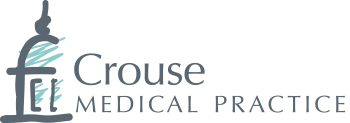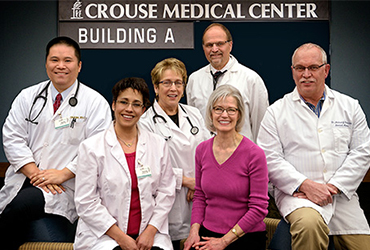
A stroke occurs when brain cells die due to disruption of blood flow to the brain. Stroke is the third leading cause of death in the U.S., but because of the significant improvement in the treatment and care protocols, in the last decade, there has been a steady decline in mortality rates and a significant improvement in the quality of life for patients who suffer a stroke.
Recognizing the symptoms of stroke, rapid intervention, and selecting a hospital that, like Crouse Health, is a certified Comprehensive Stroke Center, represent the best prospects for positive outcomes.
Types of Stroke
Ischemic Stroke
An ischemic stroke occurs as a result of a blockage within a blood vessel that supplies blood to the brain. This is the more common form of stroke. There are two types of ischemic strokes:
- Thrombotic (cerebral thrombosis) occurs when blood flow is blocked by a blood clot in an artery in the brain which is damaged by atherosclerosis, or fatty deposits in vessel walls.
- Embolic (cerebral embolism) occurs when a clot or a small piece of plaque formed in one of the arteries leading to the brain or in the heart, travels to the bloodstream and block the blood flow to the brain in narrower brain arteries.
Hemorrhagic Stroke
A hemorrhagic stroke occurs as a result of a weakened vessel that ruptures into the surrounding brain. There are two types of weakened vessels that cause this type of stroke:
- Aneurysm: Ballooning of a weakened region of a blood vessel.
- Arteriovenous Malformation (AVM): Cluster of abnormal blood vessels. It can also be caused when small vessels rupture due to uncontrolled high blood pressure.
Transient Ischemic Attack
Also referred to as “TIA” or “mini stroke." These attacks are caused by clots, but the blockage of the blood flow to the brain is transient or temporary. Symptoms of TIA will appear rapidly and usually last less than five minutes and cause no permanent damage. A TIA should serve as a warning sign, and warrants immediate medical attention. TIAs are often a precursor to stroke and about a quarter of stroke patients experience this warning of impending serious stroke. TIAs should be treated urgently in order to prevent future stroke.
Stroke Treatments
Ischemic Stroke Treatments
- Tissue Plasminogen Activator (tPA): This is the gold standard of treatment for ischemic strokes. The medication is given intravenously and works by dissolving the blood clot and improving blood flow to the affected area of the brain. tPA must be administered within a few hours of the initial stroke symptoms, thus why it is so important to identify stroke symptoms as soon as possible and immediately seek medical treatment.
- tPA, can also be administered directly to the occluding thrombus via a micro-catheter. The time limit to implement this type of intervention is longer than that for IV TPA. Generally, only Comprehensive Stroke Care Centers, such as Crouse Hospital, offer this type of treatment.
- Endovascular Clot Retrival: Specially trained surgeons remove the blood clot by sending a catheter directly to the site of the blocked vessel and restore blood flow to the affected area.
Hemorrhagic Stroke Treatments
- Endovascular Procedures: Specially trained surgeons use procedures to reduce the risk that the weakened blood vessel will rupture and cause more bleeding
- Surgical treatment: To stop bleeding and relieve pressure inside the skull
TIA or Stroke Symptoms
It is important to recognize stroke symptoms. If you or a loved one experience any one of the following symptoms, it is important to dial 911 immediately and get to a hospital.
There is a common acronym to help remember the most common signs and symptoms of stroke:
- F - Face drooping
- A - Arm weakness
- S - Speech difficulty
- T - Time to call 911
Additional Stroke Symptoms include:
- Numbness, weakness or tingling of the face, arm or leg, usually on only one side
- Sudden confusion, trouble speaking or understanding
- Vision loss in one or both eyes
- Sudden severe headache with no apparent cause
- Trouble walking, dizziness, or loss of balance and coordination
Risk Factors and Prevention
Approximately 80% of all strokes are preventable. Management of key risk factors can help prevent stroke. Some key risk factors include:
- Hypertension or uncontrolled blood pressure
- Cigarette smoking
- High cholesterol
- Atrial fibrillation
- Sedentary Lifestyle
Crouse Neurovascular specialists might recommend some of the following therapies to help prevent stroke:
- Anticoagulant/Antiplatelet Therapy: These medications (aspirin, Plavix, warfarin, etc.) interfere with the blood’s ability to clot and can play a key role in preventing ischemic stroke.
- Anti-hypertensives: Medications that treat high blood pressure
- Cholesterol medications: Lower cholesterol and decrease the probability of plaque depositing in blood vessels.
Follow-up stroke treatment is also especially important. Crouse Medical Practice stroke treatment specialists are experienced in helping patients achieve the best possible recovery after a stroke.
For more information or to schedule an appointment, please call (315) 701-2550.

